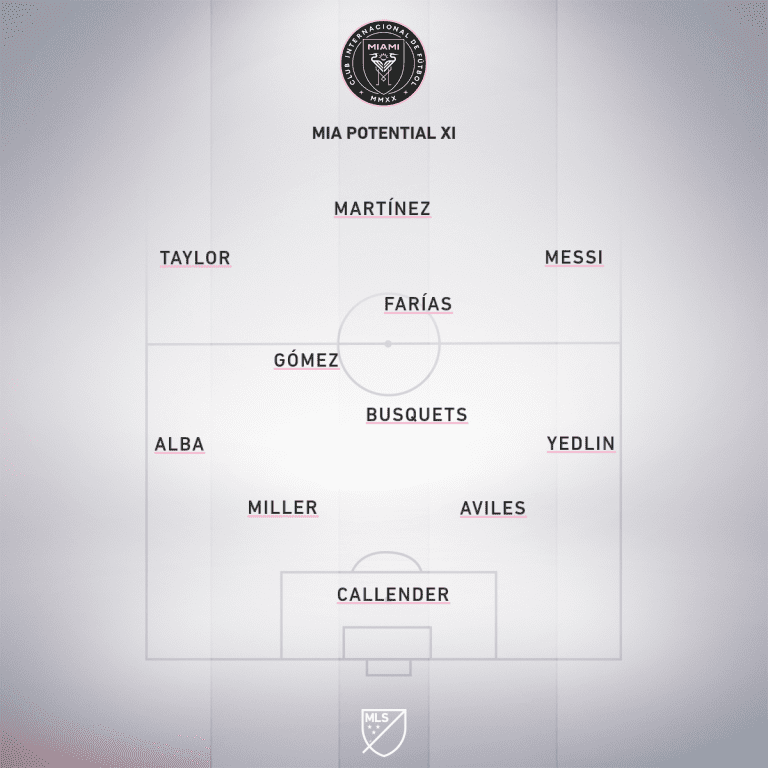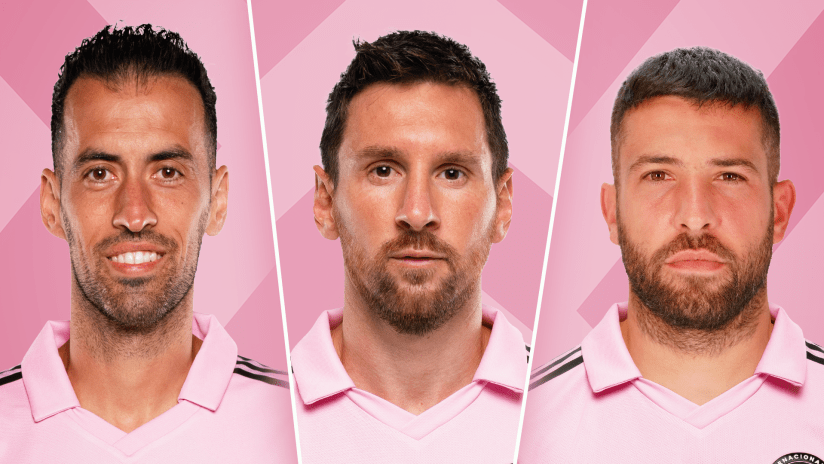“We’ve been preparing for this for a very long time.”
That was Inter Miami CF majority owner Jorge Mas, via the Offside with Taylor Twellman podcast, reflecting on the club’s Secondary Transfer Window – one that will go down as perhaps the best in MLS history.
The club brought in six new signings (potentially over half a starting XI!) from mid-July to early August, all before the window shut Wednesday evening.
- Lionel Messi (free agent) – Designated Player deal for seven-time Ballon d’Or winner and arguably greatest-ever player
- Sergio Busquets (free agent) – Designated Player deal for legendary Spain and FC Barcelona midfielder
- Jordi Alba (free agent) – non-Designated Player deal for legendary Spain and FC Barcelona left back
- Diego Gómez (transfer) – U22 Initiative midfielder from Paraguayan side Libertad
- Facundo Farías (transfer) – U22 Initiative attacker from Argentine side Colón
- Tomás Avilés (transfer) – U22 Initiative center back from Argentine side Racing Club
It’s all produced a simple question: How did Inter Miami pull this off?
Let’s peel back the layers to better understand the MLS roster mechanisms the Herons utilized at a breakneck pace, setting a new transfer-market bar for their peers.
MLS Roster 101
Before anything, let’s understand some key MLS roster rules and how they function. Things can get complicated, so we’ll try and simplify it.
Salary cap
MLS clubs operate within a salary cap, creating balance and parity throughout the league. It’s the same figure ($5,210,000) for each team and players fall into different categories based on a variety of factors. An MLS club's active roster is comprised of up to 30 players.
Designated Players
Teams can sign up to three of these players, whose total cost (compensation and acquisition) exceeds the Maximum Salary Budget Charge ($651,250). Financially, anything above that figure is paid by the club’s ownership group. It means a DP can be paid a seven-figure or eight-figure salary, but only a (often comparatively small) percentage of that counts against the salary cap.
U22 Initiative
Each MLS team can roster up to three of these players, and the number of slots available is based on the club’s use of its third DP slot. These players bring 1) a smaller Salary Budget Charge and 2) can’t have a salary that exceeds the Maximum Salary Budget Charge ($651,250). However, clubs aren’t restricted in how much they pay for a transfer or loan fee, allowing ownership groups to spend as they desire. Signings are eligible for this status at age 22 or younger and often come from abroad (though it also rewards high-performing domestic talent).
For those who prefer a deep dive, check out the full 2023 MLS Roster Rules and Regulations.
The ex-Barça trio
As recently as the 2020-21 European season, Messi, Busquets and Alba were competing in LaLiga, UEFA Champions League and more for FC Barcelona. Now, their elite skill and chemistry are raising the standard and ceiling for Inter Miami.
Timeline-wise, here’s what took place with these three big names.
Lionel Messi: July 15
The Argentine superstar’s contract at French powerhouse side Paris Saint-Germain expired this summer, making him a free agent six months after lifting the 2022 FIFA World Cup trophy.
Reports lingered about everything ranging from a Ligue 1 stay to a sentimental Barça return to a lucrative offer from the Saudi Pro League. All along, Miami’s ownership group remained confident that their offer was compelling and powerful enough to convince the GOAT he should come to MLS.
Then, on June 8, Messi sent shockwaves when stating his intention to join the South Florida-based club. He didn’t formally sign the contract until July 15, ironing out details of a reported one-of-its-kind deal involving the club, adidas and Apple. Patience and anticipation were rewarded, bringing worldwide attention to Miami.
Messi, unsurprisingly, occupies a DP spot. His deal runs through the 2025 MLS season.
Sergio Busquets: July 16
On May 10, Busquets formally announced he would leave Barça after nearly two decades at the club. And, much like Messi, speculation followed that he would be the latest star to join the Saudi Pro League.
However, a reunion with Messi was too enticing to turn down. The deep-lying midfielder became Miami’s second summertime signing on July 16, inking a DP deal through the 2025 MLS season.
The Busquets announcement came hours before a memorable unveiling ceremony at DRV PNK Stadium, when he and Messi were welcomed by adoring fans in a rainstorm (!).
Jordi Alba: July 20
The moves just kept coming, with Alba joining Miami through the 2024 MLS season with an option for 2025. The world-class left back, crucially, doesn’t occupy a DP roster slot and, just like Messi and Busquets, joined as a free agent.
Alba, in his first Inter Miami press conference, said there were bigger offers he considered. But the project, with Messi as the figurehead, was too hard to pass up.
For emphasis: None of Messi, Busquets or Alba required a transfer fee to join Miami. They had their choice of clubs and picked MLS.
U22 newcomers
Here’s where the DP roster rules become important. Brazilian midfielder Gregore is in the buy-down DP range, while Messi and Busquets count as senior DPs. That combination ensured Miami could pursue three U22 signings this summer, rather than being limited to one if they had three senior DPs (like at some other MLS clubs).
With chief soccer officer/sporting director Chris Henderson working his magic, new head coach Gerardo “Tata” Martino weighing in and ownership willing to spend, Miami identified their targets and got deals over the line.
Timeline-wise, here’s when three rising South American talents arrived on long-term deals.
Diego Gómez: July 19
Gómez, a big part of Paraguay’s future, joined Miami amid a massive global transfer spotlight. He developed at Libertad, a Paraguayan club Martino managed on two different occasions. Now, Gómez could partner with Busquets as a double-pivot in the club’s preferred 4-3-3 formation.
Facundo Farías: July 29
The chance to play alongside Messi in the attack? That’s hard for any player to turn down, and it surely helped entice Farías to join the Herons. He arrived from Argentine top-flight side Colón and has been likened to former Albiceste star Carlos Tevez.
Tomás Avilés: Aug. 1
The last U22 player to join Miami this summer, Avilés feature for Argentina at the FIFA U-20 World Cup this past spring. He joins a center-back corps that includes Canadian international Kamal Miller and Ukrainian international Sergii Kryvtsov. Whether it’s for depth or starter’s minutes, Avilés has a bright future.
Extra U22 note: It’s gotten lost in the shuffle, but Miami have winger Emerson Rodríguez out on loan at Liga MX side Santos Laguna. That transaction, completed last winter, helped leave open a U22 slot.
Making space
Whether it was Mas, Henderson or Martino, club officials often spoke about the need to subtract if they were going to fulfill their roster vision.
This manifested across a few roster aspects.
DP shuffling
Rodolfo Pizzaro, Miami’s first-ever DP signing, formally left the club on July 14 via a mutual contract termination. He then joined Greek Super League club AEK Athens, helping solve what could have been a logjam situation. Further, the club converted forward Leo Campana from being a Young DP as his budget charge was low enough to utilize that roster and budget re-classification.
Those two moves helped Miami open up two DP slots, which they used to sign Messi and Busquets. All the while, due to Gregore’s budget charge, Miami could sign the full complement of three U22 Initiative players.
Further, striker Josef Martínez hasn’t counted as a DP despite being one during his legendary time at Atlanta United. The Venezuelan star joined last winter after being declared Atlanta's buyout.
Season-ending injuries
Midfielder Corentin Jean and defenders Franco Negri and Ian Fray are all out with season-ending injuries, opening up some roster space for the club.
Buyout
One more: Miami opened up additional funds by exercising a contract buyout on goalkeeper Nick Marsman, who was yet to play in 2023.
What now?
If all pans out for Miami, a magical back half of the 2023 season (and maybe even a trophy).
The Herons have already made the Leagues Cup Round of 16, they’ll play a US Open Cup semifinal on Aug. 23 and they have a 12-point gap to make up in the standings (with games in hand) to become one of the Eastern Conference’s nine Audi MLS Cup Playoffs qualifiers.
In a matter of weeks, the club has gone from lengthy losing streaks to being reborn behind Messi’s arrival, five other marquee signings and a supporting cast raising their level – all while Martino’s decades of experience provide structure.
Miami, completely transformed in one summer transfer window, have become the story everyone’s talking about. Now, it’s about seeing how far this ride will go.















